Find EPISODE 1 of the dc project !
Have you made your first swatch from Episode 1 yet ? Great ! Take it in front of you and let’s explore all the differences we can find between
– dc in both loops
– dc in front loop
– dc in back loop
(all worked in rows at this stage)
1/ TEXTURE & VISUAL APPEARANCE:
The most obvious difference is in the texture and visual look.
Both loops => flat surface, stitches look neatly stacked on top of each other
Back loop => all but flat: very textured, with ridges in relief which makes the fabric fold itself along those ridges as soon as you hold it horizontally.
Front loop => flat surface, very slightly undulating. Very visible horizontal line dividing every set of 2 rows (= easy to count rows)
Also, when you hold your swatch in front of a window, you’re in for a surprise: the gaps between each dc are not the same !
Striking to realise that the gaps are really obvious between each dc in both loops, yet you can hardly see any gap between each dc in the front loop. (dc in back loop being somewhat in between). Interesting… That’s certainly something to keep in mind when making a sweater or skirt: depending on how much see-through you want, you might decide to use one option or the other..
2/ SIZE
Let’s take measurements of each section of your swatch. Here’s what I found on mine, measuring over 15 sts and 4 rows :
(reminder: I used the same size of hook to crochet each stitch variation!!)
Both loops => width 10.3 cm – height 4.5 cm => Let’s use this is as our reference for this project.
Back loop => width 8.6 cm – height 4.85 cm => Dc in the back loop is 17% narrower and 8% taller than dc in both loops.
Front loop => width 8.4 cm – height 5.4 cm => Dc in the front loop is 19% narrower and 20 % taller than dc in both loops.
Whoah !! What a difference that makes, right ?!! Knowing this means several things:
– working in only one loop of each stitch tends to stretch the fabric vertically, making it narrower. Which is quite logical when you think of it…
– don’t switch between one and another when using a crochet pattern specifically asking you to work in both/front/back loop. That would totally modify the final measurements of your piece.
– you could use those properties to shape a garment: imagine starting a skirt in the front loop (= narower) then switching to both loops to make it wider.. (texture and visual appearance being another story here…)
3/ STRETCH & DRAPE
Now, those parameters are more difficult to assess on such a small swatch. But here’s what I learnt from experience. You can also stretch your swatch in all directions to notice the differences:
Both loops => solid fabric. sturdy. does not stretch much vertically.
Back loop => a lot of vertical stretch. with those ridges, fabric could look thicker than dc in both loops. folds very easily along ridges, thus following curves of body.
Front loop => quite stretchy in both directions (not as much than the back loop vertically though !). fabric is visibly thinner than both other samples and has lots of drape.
The one thing I like to remember is that when working in only ONE loop, each double crochet is stretched lengthwise, making the fabric thinner (closer to knit Stockinette stitch) and giving it more stretch.. and drape.
4/ BEST USES
Now, with all these parameters in mind, let’s try and see which types of project use each variation of the dc :
Both loops => projects which require durability and as little stretch as possible: home decor, potholders, bags …
Back loop => textured sections of a project, typically to mimic ribbing when worked sideways (cuffs..) or need to be quite stretchy and elastic. Working just 1 row in the back loop could also make a perfect folding transition between base and sides of a bag with flat bottom.
Front loop => projects which require thinner fabric, stretchiness and drape: it’s ideal to make garments, as it follows the curves of the body and will stretch where needed. The fact that the fabric is thinner, and with hardly any gap in between stitches is also a plus in my book !
5/ WORKING IN THE ROUND
Working in the round changes the visual aspect of all 3 of those stitch variations. I’ll explore this in a further episode…
*********************************************************************************************************************************************
How about YOU ? Anything I forgot or didn’t see in those swatches ? Please share in the comments !
*********************************************************************************************************************************************
DC project Episode 1
DC project Episode 2
DC project Episode 3
DC project Episode 4
DC project Episode 5
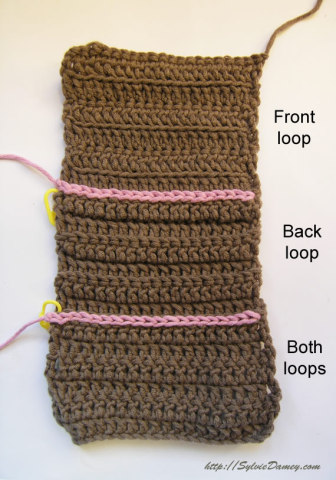
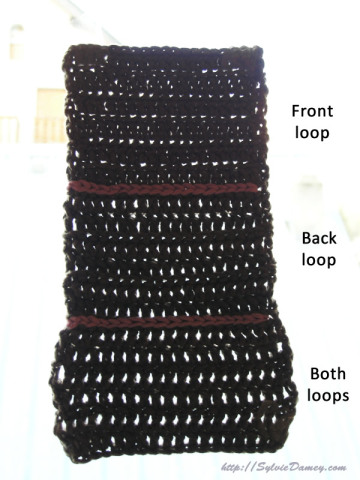
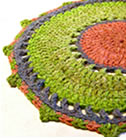
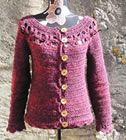
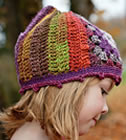
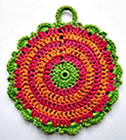
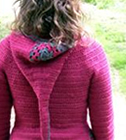
Nice compendium you’re building here… and a good review. 😉 I always thought dc in the back loop was the same as dc in the front loop, just on the wrong side. Surprised to see that it looks so different. Looking forward to your thoughts on dc in the round. And don’t forget linked dc.